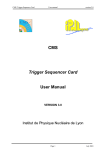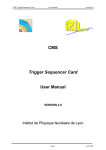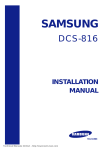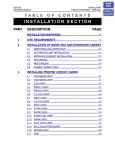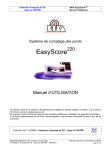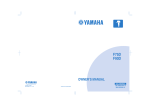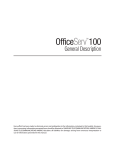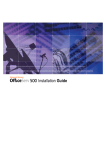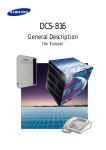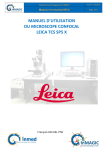Download Samsung DCS COMPACT II Unit installation
Transcript
PROSTAR DCS COMPACT TECHNICAL MANUAL T A B L E INSTALLATION TABLE OF CONTENTS JUNE 2001 O F Table of Contents C O N T E N T S INSTALLATION SECTION PART DESCRIPTION PAGE 1 SITE REQUIREMENTS ................................................................... 1–1 2 INSTALLATION OF BASIC KSU AND EXPANSION KIT 3 4 HOME PAGE 2.1 UNPACKING AND INSPECTION .................................................. 2–1 2.2 KEY SERVICE UNIT INSTALLATION ............................................ 2–1 2.3 EXPANSION KIT INSTALLATION .................................................. 2–1 2.4 GROUNDING ............................................................................... 2–2 2.5 MDF CABLING ............................................................................. 2–4 INSTALLING PRINTED CIRCUIT CARDS 3.1 RAM PACK .................................................................................... 3–1 3.2 4 CO PROTECTION CARD ........................................................... 3–1 3.3 2 SLI CARD ................................................................................... 3–1 3.4 MISC 1 CARD ............................................................................... 3–1 3.5 MISC 2 CARD ............................................................................... 3–1 3.6 2 X 4 DLI CARD ............................................................................ 3–2 3.7 2 X 4 SLI CARD ............................................................................ 3–2 3.8 2 E&M 4 DLI CARD ...................................................................... 3–2 POWER UP PROCEDURES 4.1 CONNECT POWER TO THE SYSTEM ......................................... 4–1 4.2 RAM CARD INDICATIONS ............................................................ 4–1 4.3 PCB VERIFICATION ..................................................................... 4–1 4.4 DEFAULT TRUNK AND STATION NUMBERING ........................... 4–2 PROSTAR DCS COMPACT TECHNICAL MANUAL 5 6 INSTALLATION TABLE OF CONTENTS JANUARY 2002 CONNECTING TELCO CIRCUITS 5.1 SAFETY PRECAUTIONS .............................................................. 5–1 5.2 LOOP START LINES ..................................................................... 5–1 5.3 OFF PREMISE EXTENSIONS (OPX) ............................................ 5–1 5.4 E&M TIE LINES ............................................................................ 5–1 CONNECTING STATION EQUIPMENT 6.1 SAFETY PRECAUTIONS .............................................................. 6–1 6.2 DCS COMPACT KEYSET .............................................................. 6–1 6.3 ADD-ON MODULE ........................................................................ 6–1 6.4 SINGLE LINE TELEPHONE ......................................................... 6–1 6.5 DOOR PHONE AND DOOR LOCK RELEASE............................... 6–1 6.6A WALL-MOUNTING KEYSETS ....................................................... 6–2 6.6B WALL-MOUNTING KEYSETS WITH ULTRA BASE WEDGE ......... 6–2 6.6C WALL-MOUNTING iDCS KEYSETS .............................................. 6–2 6.7 7 8 ATTACHING DCS 32 BUTTON AOM TO MASTER STATION ........ 6–3 CONNECTING OPTIONAL EQUIPMENT 7.1 MUSIC ON HOLD/BACKGROUND MUSIC ................................... 7–1 7.2 EXTERNAL PAGING ..................................................................... 7–1 7.3 COMMON BELL ........................................................................... 7–1 7.4 RING OVER PAGE ........................................................................ 7–2 7.5 STATION MESSAGE DETAIL RECORDING (SMDR)..................... 7–2 7.6 PC PROGRAMMING..................................................................... 7–2 7.7 REMOTE PROGRAMMING........................................................... 7–3 7.8 POWER FAILURE TRANSFER (PFT) ............................................ 7–3 7.9 VOICE MAIL/AUTO ATTENDANT ................................................. 7–3 7.10 COMPUTER TELEPHONY MODULE (CTM) ................................. 7–3 INSTALLING KEYSET DAUGHTERBOARDS 8.1 KDB DLI ........................................................................................ 8–1 8.2 KBD SLI ........................................................................................ 8–1 8.3 CONNECTING TO THE KDBS...................................................... 8–1 HOME PAGE Table of Contents PROSTAR DCS COMPACT TECHNICAL MANUAL 9 10 11 12 13 INSTALLATION TABLE OF CONTENTS JUNE 2001 CHANGING SOFTWARE 9.1 ACCESSING THE EPROMS ......................................................... 9–1 9.2 REPLACING THE EPROMS ......................................................... 9–1 INSTALLING CALLER ID 10.1 GENERAL INFORMATION ......................................................... 10–1 10.2 INSTALLING ON A NEW SYSTEM ............................................. 10–2 10.3 INSTALLING ON A SYSTEM WITH A MISC 1 CARD .................. 10–2 10.4 INSTALLING ON A SYSTEM WITHOUT A MISC CARD .............. 10–3 ADDING CARDS TO AN EXISTING SYSTEM 11.1 ADDING A MISC CARD .............................................................. 11–1 11.2 ADDING A 2 SLI CARD ............................................................... 11–1 11.3 ADDING A 2 X 4 CARD ............................................................... 11–1 UPGRADING A SYSTEM TO RELEASE 2 12.1 INSTALLING ON A SYSTEM WITH A MISC CARD ..................... 12–1 12.2 INSTALLING ON A SYSTEM WITHOUT A MISC CARD .............. 12–1 INSTALLING A SVMi-4 CARD 13.1 SYSTEM SIZE WITH A SVMi-4 INSTALLED................................ 13–1 13.2 UPGRADING THE SVMi-4 TO FOUR PORTS ............................. 13–1 HOME PAGE Table of Contents PROSTAR DCS COMPACT TECHNICAL MANUAL INSTALLATION PART 1 DECEMBER 1994 Table of Contents PART 1. SITE REQUIREMENTS When planning the installation of the DCS COMPACT, choose a site that meets the following requirements: z z z z z z z z Select a location for the key service unit (KSU) that has enough space for easy installation and adequate lighting (see Figure 1–1). Select a location that will minimize cable lengths. See the Cable Requirements table below. The equipment should not be exposed to direct sunlight, corrosive fumes, dust, constant vibration or strong magnetic fields such as those generated by motors and copy machines. A direct commercial AC power outlet is required. Do not use extension cords. Preferably, a dedicated circuit should be used to minimize the risk of other electrical equipment being connected that could adversely affect system operation. Ensure that all wires and cable going to and coming from the KSU are properly routed. Do not cross fluorescent lights or run parallel with AC wires. The equipment must be located in an environment that will maintain a temperature range of 32°–104°F (0°–40°C) and a humidity range of 10%–90% non-condensing. Allow at least 6" clearance on both sides and 6" clearance on top of the KSU to ensure proper ventilation. Do not install in close proximity to a fire sprinkler head or other sources of water. Meeting these requirements will help to ensure proper performance and greater life expectancy of the system. CABLE REQUIREMENTS EQUIPMENT CABLE AWG MAX FEET MAX METERS DIGITAL KEYSETS 1 PR. TWISTED 24 1300 400 ADD-ON MODULES 1 PR. TWISTED 24 1300 400 SINGLE LINE STATION 1 PR. TWISTED 24 3000 1 KM DOOR PHONE 2 PR. TWISTED 24 330* 100 SIM 1 PR TWISTED 24 1300 400 *This is the maximum distance a door phone can be from the DPIM. The DPIM can be a maximum of 900 cable feet from the KSU. 1–1 HOME PAGE PROSTAR DCS COMPACT TECHNICAL MANUAL INSTALLATION PART 1 DECEMBER 1994 HOME PAGE Table of Contents 22.5" 5" 14.25" KEY SERVICE UNIT DIMENSIONS FIGURE 1– 1 PROSTAR DCS COMPACT TECHNICAL MANUAL INSTALLATION PART 2 JUNE 1995 PART 2. INSTALLATION OF BASIC KSU AND EXPANSION KIT 2.1 UNPACKING AND INSPECTION After unpacking the KSU, inspect for signs of physical damage. If any damage is detected, do not attempt to install. Contact Samsung Telecommunications America, Technical Support Department. Check to see that the KSU carton includes the following items: z z z Key Service Unit 4 Central Office Protection (4 COP) card Wall-mount kit consisting of three screws Check to see that the EXPANSION KIT carton includes the following: z z z Expansion backplane Plastic card rack Vinyl bag with screws and cables 2.2 KEY SERVICE UNIT INSTALLATION The Key Service Unit (KSU) must be wall-mounted. The KSU should be mounted on a plywood backboard at least 5/8" thick. Attach a mounting screw to the backboard. Next hang the KSU on the screw and secure it to the backboard with the remaining two screws (see Figure 2–1). 2.3 EXPANSION KIT INSTALLATION 1. Mount the expansion backplane in the basic KSU and attach it securely with the five screws supplied. Take care not to over-tighten the screws and damage the PCB (see Figure 2–2). 2. Connect the expansion backplane to the basic KSU by plugging one end of the ribbon cable into the socket on the KSU motherboard and the other end into the expansion backplane. NOTE: It is recommended that the ribbon cable be attached to the expansion baseboard before it is installed in the KSU. 3. Connect the ground wires from the expansion backplane to the connectors on the KSU motherboard. 4. Fit the plastic card rack to the basic KSU and secure with the three screws that are supplied. Take care not to over-tighten the screws and strip the threads (see Figure 2–3). 2–1 HOME PAGE Table of Contents PROSTAR DCS COMPACT TECHNICAL MANUAL INSTALLATION PART 2 JUNE 1995 HOME PAGE Table of Contents 2.4 GROUNDING In order to comply with the revised UL 1459 Telephone Equipment document, the following paragraphs must be incorporated into this installation manual. “UL 1459 Paragraph 66. To be included in Installation Instructions. “66.1.A An equipment grounding conductor that is not smaller in size than the ungrounded branch-circuit supply conductors is to be installed as part of the circuit that supplies the product or system. Bare, covered, or insulated grounding conductors are acceptable. Individually covered or insulated equipment grounding conductors shall have a continuous outer finish that is either green, green with one or more yellow stripes. The equipment grounding conductor is to be connected to ground at the service equipment. “66.1.B The attachment-plug receptacles in the vicinity of the product or system are all to be of a grounding type, and the equipment grounding conductors serving these receptacles are to be connected to earth ground at the service equipment. “Paragraph 66.1 revised December 13, 1991.” WARNING: HIGH LEAKAGE CURRENT Earth Connection Essential Before Connecting Supply The DCS COMPACT system requires a supplementary (see below) earth ground to be connected to the KSU in addition to the third wire ground. The grounding lug on the bottom of the KSU must be connected to a ground rod, bonded building steel or cold water pipe using at least #16 AWG copper wire (see Figure 2–4). The third wire ground should not be removed as previously stated in early release manuals. The following is a definition of a supplementary ground as defined by UL 1459 Telephone Equipment. “Paragraph 66. To be included in the Installation Instructions. “66.2.A A supplementary equipment grounding conductor shall be installed between the product or system and ground that is in addition to the equipment grounding conductor in the power supply cord. “66.2.B The supplementary equipment grounding conductor shall not be smaller in size than the ungrounded branch-circuit supply conductors. The supplementary equipment grounding conductor shall be connected to the product at the terminal provided, and shall be connected to ground in a manner that will retain the ground connection when the product is unplugged from the receptacle. The connection to ground of the 2–2 PROSTAR DCS COMPACT TECHNICAL MANUAL INSTALLATION PART 2 JUNE 1995 supplementary equipment grounding conductor shall be in compliance with the rules for terminating bonding jumpers in Part K of Article 250 of the National Electrical Code ANSI/NFPA 70. Termination of the supplementary equipment grounding conductor is permitted to be made to building steel, to a metal electrical raceway system, or to any grounded item that is permanently and reliably connected to the electrical service equipment ground. “66.2.C Bare, covered, or insulated grounding conductors are acceptable. A covered or insulated grounding conductor shall have a continuous outer finish that is either green, or green with one or more yellow stripes. “Paragraph 66.2 revised September 20, 1993.” Failure to provide an adequate ground may cause a safety hazard, confusing trouble symptoms or even circuit card failure. WARNING: Unplug the power cord from the AC outlet before attempting to connect the ground. Hazardous voltage may cause death or injury. Observe extreme caution when working with AC power. What the above paragraphs mean is when conventional, analog telephone circuits are connected to the DCS COMPACT system, under fault conditions (e.g., the tip and/or ring conductor is crossed with a power line, the circuit is affected by lightning during a storm), it is possible for hazardous potentials to appear across the tip and ring wiring coming into the DCS COMPACT cabinet from the outside plant (e.g., overhead cables, buried cables, cable head pedestal). These circuits are provided with both primary and secondary protection circuitry which will attempt to drain off these high voltages and currents to earth ground. Obviously, it is important to have a good source of ground connected to the DCS COMPACT system to which to drain this energy off. Also, certain metallic analog circuits (e.g., E & M trunks) require a current flow to earth ground to accommodate normal operating conditions and/or to resolve fault conditions. Again, a good earth ground source is required by the DCS COMPACT system. The DCS COMPACT system is grounded in two ways. One way is via the green wire in the power cord connected to the AC power outlet. However, this can be disconnected either intentionally or unintentionally. Consequently, a second or supplementary more permanent ground connection is provided by connecting a high current/voltage capacity ground wire which is bonded to ground at the electric service power entrance or via some other method approved by the National Electrical Code to the DCS COMPACT system ground lug. This is a more secure ground connection which can only be disconnected intentionally. These precautions are basically taken for safety reasons to protect personnel working on the DCS COMPACT system and also for operational reasons to accommodate ground return and/or ground referenced analog telephone circuits which require this solid earth ground connection for normal functioning. 2–3 HOME PAGE Table of Contents PROSTAR DCS COMPACT TECHNICAL MANUAL INSTALLATION PART 2 JUNE 1995 HOME PAGE Table of Contents 2.5 MDF CABLING All connections to the DCS COMPACT system are made by way of a customerprovided main distribution frame (MDF). The KSU and expansion kit are each connected to the MDF using a 25 pair female amphenol-type cable. These cables can be routed into the KSU cabinet from below. Label each cable to correspond with the connector numbers (see Figure 2–4). Label each 66 terminating block with the same connector number with which the cable is labeled. Use one pair twisted jumper wire to cross-connect stations or lines to their associated port. 2–4 PROSTAR DCS COMPACT TECHNICAL MANUAL INSTALLATION PART 2 DECEMBER 1994 HOME PAGE Table of Contents UPPER MOUNTING HOLE POWER ON OFF _ 0 LOWER MOUNTING HOLES KSU MOUNTING HOLES FIGURE 2– 1 PROSTAR DCS COMPACT TECHNICAL MANUAL INSTALLATION PART 2 FEBRUARY 1996 HOME PAGE Table of Contents SCR5 SCR1 BACKPLANE MOUNTING SCREWS P2 SCR2 SCR3 LOCATION OF BACKPLANE MOUNTING SCREWS SCR4 FIGURE 2– 2 RACK MOUNTING SCREWS SCR5 SCR1 P2 SCR2 SCR3 LOCATION OF RACK MOUNTING SCREWS SCR4 FIGURE 2– 3 PROSTAR DCS COMPACT TECHNICAL MANUAL INSTALLATION PART 2 DECEMBER 1994 HOME PAGE Table of Contents SCR1 SCR5 EXPANSION SLOT 3 EXPANSION SLOT 2 EXPANSION SLOT 1 P2 SCR2 SCR3 SCR4 4 COP SLOT PSU RAM PACK SLOT 2 SLI SLOT MISC SLOT GROUND LUG THIRD WIRE GROUND KEY SERVICE UNIT GROUNDING TO POWER OUTLET FIGURE 2– 4 PROSTAR DCS COMPACT TECHNICAL MANUAL INSTALLATION PART 3 DECEMBER 1994 PART 3. INSTALLING PRINTED CIRCUIT CARDS Unpack and inspect each card before installing. Check for signs of physical damage. If any damage is detected, do not attempt to install. Contact Samsung Technical Support immediately. 3.1 RAM PACK (Figure 3– 2) Select the appropriate type of RAM pack for the system. Most systems can utilize a RAM-1 card; however, systems with Caller ID and those wanting 1500 speed dial numbers require the RAM-2 card. Make sure that the BACK UP switch is in the OFF position. Insert the RAM card in the KSU slot labeled RAM (see Figure 3–1). Push firmly in the middle of the RAM pack to ensure that it is fully inserted into the backplane connector. To prevent accidental damage to the RAM card, the RAM connector on the backplane is positioned to mate only with the RAM card. Other interface cards will not mate with this connector and the RAM card will not mate with any other connector. 3.2 4 CO PROTECTION CARD (Figure 3– 3) This card has no selectable options. Insert the 4 CO protection card into the appropriate slot (see Figure 3–1). Push firmly in the middle of both card ejectors to ensure that it is fully inserted into the back plane connector. 3.3 2 SLI CARD (Figure 3– 4) This card has no selectable options. Insert the 2 SLI card into the appropriate slot (see Figure 3–1). Push firmly in the middle of both card ejectors to ensure that it is fully inserted into the back plane connector 3.4 MISC 1 CARD (Figure 3– 5) There are no options to select on this card. Insert the MISC card into the appropriate slot. Push firmly in the middle of both card ejectors to ensure that it is fully inserted into the back plane connector. NOTE: Only one MISC card can be installed in a system. 3.5 MISC 2 CARD (Figure 3– 5) There are no options to select on this card. Insert the MISC card into the appropriate slot (see Figure 3–1). Push firmly in the middle of both card ejectors on each card to ensure that it is fully inserted into the back plane connector. NOTE: Only one MISC card can be installed in a system. 3–1 HOME PAGE Table of Contents PROSTAR DCS COMPACT TECHNICAL MANUAL INSTALLATION PART 3 NOVEMBER 1997 Table of Contents 3.6 2 X 4 DLI CARD (Figure 3– 7) There are no options to select on this card. Insert the 2 X 4 DLI card into any slot on the expansion backplane (see Figure 3–6). Push firmly in the middle of both card ejectors on each card to ensure that it is fully inserted into the back plane connector. 3.7 2 X 4 SLI CARD (Figure 3– 7) There are no options to select on this card. Insert the 2 X 4 SLI card into any slot on the expansion backplane (see Figure 3–6). Push firmly in the middle of both card ejectors on each card to ensure that it is fully inserted into the back plane connector. 3.8 2 E&M 4 DLI CARD (Figure 3– 8) The E&M trunk circuits on this card can be set to provide either Type 1 or type 5 operation. Type 1 operation is used when connecting to Telco circuits and type 5 is used when connecting “back to back” across a private cable. Set the jumpers located between the two relays (see Figure 3–8) according to the table below. Both of the jumpers for each circuit must be set to the same type for correct operation. CIRCUIT JUMPER POSITION TYPE 1 J1 T1 TYPE 1 1 J1 T5 TYPE 5 1 J2 T1 TYPE 1 1 J2 T5 TYPE 5 2 J3 T1 TYPE 1 2 J3 T5 TYPE 5 2 J4 T1 TYPE 1 2 J4 T5 TYPE 5 WARNING: Turn the system off and remove the card from the system before attempting to change jumper settings. 48 volts is present on the jumpers at all times the system is turned on. NOTE: When set to TYPE 1 the E&M Tie line circuits on this card are USOC TYPE TL11M. 3–2 HOME PAGE PROSTAR DCS COMPACT TECHNICAL MANUAL INSTALLATION PART 3 DECEMBER 1994 HOME PAGE Table of Contents 4 COP SLOT PSU RAM PACK SLOT 2 SLI SLOT MISC SLOT 408 KSU SLOT POSITIONS FIGURE 3– 1 PROSTAR DCS COMPACT TECHNICAL MANUAL INSTALLATION PART 3 DECEMBER 1994 HOME PAGE Table of Contents RE SE T B OFACK UP F ON RU UP N DCS COMPACT RAM PACK FIGURE 3– 2 PROSTAR DCS COMPACT TECHNICAL MANUAL INSTALLATION PART 3 DECEMBER 1994 HOME PAGE Table of Contents 4TRK R405 R305 C402 D402 D404 R205 C302 D304 D204 D302 R105 C202 C102 D401 D104 D202 D301 D201 D101 U301 U201 U101 D102 U403 U402 U303 U302 D403 C404 C407 U203 U202 D303 C304 C307 RLY8 C204 C207 RLY7 T3 C201 RLY3 DSS2 DSS7 DSS5 DSS3 DSS1 C101 RLY2 RLY1 C1 BAR CODE P4 4 CO PROTECTION CARD RW3 BAR CODE P3 FIGURE 3– 3 DCS COMPACT (2SLC) C104 C312 C311 DSS4 T1 T2 RLY4 DSS6 RLY5 C301 T4 D103 DSS8 C104 C107 RLY6 C401 U401 U103 U102 D203 RW2 HYB2 RW1 RLY2 HYB1 RLY1 T1 U101 U102 C310 C102 C101 C202 C201 T2 T301 C103 C203 C116 C308 DSSV4 U202 U201 U302 C314 R319 C301 2 SLI CARD DSSV3 DSSV2 DSSV1 C113 C5 C314 C3 P5 FIGURE 3– 4 PROSTAR DCS COMPACT TECHNICAL MANUAL INSTALLATION PART 3 DECEMBER 1994 HOME PAGE Table of Contents PORT 2 TNR1 P7 U6 C10 BAR CODE U5 Y2 C12 U4 U7 T1 C14 C15 C17 U1 Y1 TNR4 U8 TNR3 TNR2 U3 U2 P1 P2 PORT 1 DCS COMPACT (MISC) MISC CARD FIGURE 3– 5 PROSTAR DCS COMPACT TECHNICAL MANUAL INSTALLATION PART 3 DECEMBER 1994 HOME PAGE Table of Contents SCR1 SCR5 EXPANSION SLOT 3 EXPANSION SLOT 2 EXPANSION SLOT 1 P2 SCR2 SCR3 SCR4 4 COP SLOT PSU RAM PACK SLOT 2 SLI SLOT MISC SLOT EXPANSION KIT INSTALLED IN KSU FIGURE 3– 6 2 X 4 DLI CARD AND 2 X 4 SLI CARD C701 Q701 C710 C714 U702 U1 R700 C700 C3 U2 U3 C1 C5 C3 C5 DCS COMPACT (204SLT) C708 BAR CODE R719 T701 C709 C712 C711 BAR CODE DCS COMPACT (204DLI) U1 C510 U2 C310 U602 C507 C307 C402 PS1 U502 U402 U302 T1 U4 T2 HYB5 C502 PS2 U5 P1 T3 T6 T5 T4 T3 P1 C602 PS31 U6 C611 C604 C504 C511 C411 C702 PS4 C304 C404 C311 T4 U7 R603 R503 R403 R303 C202 RL4 T6 C601 HYB4 HYB3 HYB2 HYB1 RL3 C501 RL8 C602 RL7 C502 C401 RL6 C402 U201 D201 U204 U101 P2 C201 U201 D202 D203 HYBR U205 U204 R205 U104 U105 RL3 D204 C202 C116 C203 U202 C205 C113 C101 U203 U102 RL4 T2 T5 T1 U101 RL1 C103 R105 D104 RL1 R105 D103 C101 D101 D102 P2 C103 U103 U102 U105 C105 U104 C113 C116 DSSV4 DSSV3 DSSV2 DSSV1 D202 C201 C301 RL5 C203 U202 U203 D203 C302 D204 R205 C205 U205 C102 C105 D103 D102 D104 U103 RL2 C102 RL2 PROSTAR DCS COMPACT TECHNICAL MANUAL INSTALLATION PART 3 DECEMBER 1994 FIGURE 3– 7 HOME PAGE Table of Contents BAR CODE U1 C110 U2 U3 DCS COMPACT (2E&M/4DLI) T4 PS4 C402 U4 PS5 C502 2 E&M / 4 DLI CARD J3 FG NO 48 48 NC T5 T1 T5 T1 FG FG NO 48 48 NC RLY1 T3 DSS4 C212 DSS3 C289 DSS2 P2 DSS1 RLY2 T3 U23 TYPE RLY1 R203 R201 R301 U22 U21 J4 TYPE C112 R303 U33 PS32 C100 PS7 C702 U31 U32 PS31 P1 PS6 C602 T7 U7 PS22 J2 FG T6 U6 PS21 J1 J3 RLY2 T5 U5 PROSTAR DCS COMPACT TECHNICAL MANUAL INSTALLATION PART 3 NOVEMBER 1997 J1 J2 J4 FIGURE 3– 8 HOME PAGE Table of Contents PROSTAR DCS COMPACT TECHNICAL MANUAL INSTALLATION PART 4 NOVEMBER 1997 PART 4. POWER UP PROCEDURES 4.1 CONNECT POWER TO THE SYSTEM During the initial installation, it is best to verify proper system operation before plugging in any amphenol-type cables to the MDF. If you have already plugged the cables in, unplug them at this time. Verify that the AC voltage at the dedicated electrical outlet is in the range of 82–132 Volts AC. Make sure the AC power switch on the system power supply is in the OFF position and that the RAM pack battery switch is also in the OFF position. Plug the KSU power cord into the dedicated polarized AC outlet. Turn the AC power switch to the ON position. The LED on the power supply will light steady to confirm the presence of power. If the PSU LED fails to illuminate, unplug the system, remove the power supply and check the AC fuse located on the bottom. If the fuse is good but the LED does not illuminate, you must correct the problem before continuing. Turn off the power switch. Unplug all cards using the card ejectors. Turn the system on. Check the LED again. If the problem is corrected, you have a defective card. Test and remove the faulty card before continuing. If the LED still does not light, unplug the KSU and change power supplies. This in all probability will solve the problem. If it does not, contact Samsung Technical Support. 4.2 RAM CARD INDICATIONS Having verified proper operation of the power supply, visually check the RAM card indications. The LED should flicker rapidly indicating the main processor is functioning. The battery switch should now be turned ON. If the LED remains lit steady turn power to the system OFF and check the installation of the EPROM’s by removing them and checking for bent or damaged pins. If the EPROMS appear to be installed correctly and the system does not come up when turned on, Contact Samsung Technical support. The system is equipped with a halt program. When this program is running, the LED is ON steady. The system must be reset to release the halt program and restore the system to normal operation. See MMC 810 for operation of the halt program. 4.3 PCB VERIFICATION Before connecting all MDF cabling, plug in a test cable to the first DLI port. Connect a display set and verify that it is working. Use maintenance program MMC 805 (or MMC 727 for Release 2 systems) to verify the system version, software version and that all cards are recognized by the CPU. Remove the test cable and plug in all amphenol-type cables to the MDF. Proceed with the rest of the installation. 4–1 HOME PAGE Table of Contents PROSTAR DCS COMPACT TECHNICAL MANUAL INSTALLATION PART 4 NOVEMBER 1997 4.4 DEFAULT TRUNK AND STATION NUMBERING Upon initial power up, the CPU reads each slot for the existence of a card and identifies the type of card. It stores this as the default configuration. The system assigns trunk numbers beginning with 701 and continues to 704 for a basic KSU or to 710 for a fully equipped KSU. Station numbers are assigned in the same manner. The lowest station is assigned station number 201 and continues to 208 for a basic KSU or to 222 for a fully equipped KSU. Keyset daughterboards are assigned numbers beginning with 301 and continue to 310. Default data assigns the keyset in the lowest port to the operator group and all trunks ring that station until the default is changed. Station and trunk numbers can be changed, rearranged and reassigned as needed using MMC 724. 4–2 HOME PAGE Table of Contents PROSTAR DCS COMPACT TECHNICAL MANUAL INSTALLATION PART 5 NOVEMBER 1997 PART 5. CONNECTING TELCO CIRCUITS 5.1 SAFETY PRECAUTIONS To limit the risk of personal injury, always follow these precautions before connecting TELCO circuits: a. Never install telephone wiring during a lightning storm. b. Never install telephone jacks in a wet location unless the jack is specifically designed for wet locations. c. Never touch uninsulated telephone wires or terminals unless the telephone line has been disconnected at the network interface. d. Use caution when installing or modifying telephone lines. 5.2 LOOP START LINES Using one pair twisted #24 AWG or #26 AWG jumper wire, cross-connect each loop start C.O. line to the trunk port of your choice (see Figures 5–1 and 5–2). 5.3 OFF PREMISE EXTENSIONS (OPX) Using one pair twisted #24 AWG or #26 AWG jumper wire, cross-connect any 2 SLI port to telephone company OPX circuits (see Figure 5–3). Circuits on the 2 SLI card are specifically designed to meet TELCO requirements for OPX use. These circuits are provided with the same over voltage and over current protection as C.O. line circuits. Using single line stations on a 2 X 4 SLI or KDb SLI may cause damage to your equipment. There is no special programming required for OPX use; however, it is suggested that the OPX ports be set programmed as “data ring” in MMC 208 to provide a disconnect signal to the OPX equipment. The telephone company service facility interface code for this type of OPX circuit is OL13C. 5.4 E&M TIE LINES Using two pair twisted #24 AWG or #26 AWG jumper wire, cross-connect any E&M circuit to a telephone company E&M circuit (see Figure 5–4). The telephone company service facility interface code for the E&M tie line is TL11M. This is a 2 wire Type 1 tie line. NOTE: When connecting an E&M tie line in “back to back” fashion you must remember to reverse the E&M leads at one end ONLY. i.e. connect the E lead on one system to the M lead of the other system and vice versa. 5–1 HOME PAGE Table of Contents PROSTAR DCS COMPACT TECHNICAL MANUAL INSTALLATION PART 5 DECEMBER 1994 Table of Contents 25 PAIR CABLE WITH FEMALE CONNECTOR TO KSU P1 FUNCTION CIRCUIT C.O. TIP 1 C.O. RING C.O. TIP TERM COLOR PIN 1 W-BL 26 2 BL-W 1 3 W-O 27 4 O-W 2 5 W-GN 28 6 GN-W 3 7 W-BR 29 8 BR-W 4 2 C.O. RING TELCO-PROVIDED NETWORK ACCESS JACK RJ 11C RJ 14C RJ 21X CONNECT TO ANY CO CIRCUIT ON THE BASIC KSU. C.O. TIP 3 C.O. RING C.O. TIP 4 C.O. RING NOTE: ONLY LOOP START LINES CAN BE CONNECTED TO A DCS COMPACT. MDF CONNECTIONS LOOP START LINE TO BASIC KSU HOME PAGE FIGURE 5– 1 PROSTAR DCS COMPACT TECHNICAL MANUAL INSTALLATION PART 5 NOVEMBER 1997 Table of Contents 25 PAIR CABLE WITH FEMALE CONNECTOR TO EXPANSION KIT P2 FUNCTION CIRCUIT TERM COLOR PIN 1 W-BL 26 2 BL-W 1 3 W-O 27 4 O-W 2 C.O. TIP 5 W-GN 28 C.O. RING 6 GN-W 3 7 W-BR 29 8 BR-W 4 9 W-S 30 10 S-W 5 11 R-BL 31 12 BL-R 6 13 R-O 32 14 O-R 7 15 R-GR 33 16 GR-R 8 17 R-BR 34 18 BR-R 9 19 R-S 35 20 S-R 10 21 BK-BL 36 22 BL-BK 11 23 BK-O 37 24 O-BK 12 C.O. TIP C.O. RING 5 6 TELCO PROVIDED NETWORK ACCESS JACK RJ 11C RJ 14C RJ 21X C.O. TIP C.O. RING 7 C.O. TIP C.O. RING 8 C.O. TIP C.O. RING 9 C.O. TIP C.O. RING 10 CONNECT TO ANY C.O. CIRCUIT FROM ANY 2 X 4 DLI OR 2 X 4 SLI CARD MDF CONNECTIONS LOOP START LINE TO EXPANSION CARD HOME PAGE FIGURE 5– 2 PROSTAR DCS COMPACT TECHNICAL MANUAL INSTALLATION PART 5 DECEMBER 1994 HOME PAGE Table of Contents 25 PAIR CABLE WITH FEMALE CONNECTOR TO KSU P1 FUNCTION CIRCUIT SLT TIP TERM COLOR PIN 29 BK-SL 40 30 SL-BK 15 31 Y-BL 41 32 BL-Y 16 1 SLT RING SLT TIP 2 SLT RING TELCO-PROVIDED NETWORK ACCESS JACK RJ 11C RJ 14C RJ 21X CONNECT TO ANY CIRCUIT ON THE 2 SLI CARD. MDF CONNECTIONS OFF PREMISE EXTENSION FROM 2 SLI CARD FIGURE 5– 3 PROSTAR DCS COMPACT TECHNICAL MANUAL INSTALLATION PART 5 NOVEMBER 1997 Table of Contents 25 PAIR CABLE WITH FEMALE CONNECTOR TO EXPANSION KIT P2 FUNCTION CIRCUIT TERM COLOR PIN 1 W-BL 26 2 BL-W 1 E 3 W-O 27 M 4 O-W 2 C.O. TIP 5 W-GN 28 C.O. RING 6 GN-W 3 E 7 W-BR 29 M 8 BR-W 4 9 W-S 30 10 S-W 5 11 R-BL 31 12 BL-R 6 13 R-O 32 14 O-R 7 15 R-GR 33 16 GR-R 8 17 R-BR 34 18 BR-R 9 19 R-S 35 20 S-R 10 21 BK-BL 36 22 BL-BK 11 23 BK-O 37 24 O-BK 12 C.O. TIP C.O. RING TELCO PROVIDED NETWORK ACCESS JACK RJ 2GX 5 6 C.O. TIP C.O. RING 7 C.O. TIP C.O. RING 8 C.O. TIP C.O. RING 9 C.O. TIP C.O. RING 10 CONNECT TO ANY E&M CIRCUIT FROM ANY 2 E&M 4DLI. MDF CONNECTIONS E&M LINE TO EXPANSION CARD HOME PAGE FIGURE 5– 4 PROSTAR DCS COMPACT TECHNICAL MANUAL INSTALLATION PART 6 JANUARY 2002 PART 6. CONNECTING STATION EQUIPMENT 6.1 SAFETY PRECAUTIONS To limit the risk of personal injury, always follow these precautions before connecting telephone circuits: a. Never install telephone wiring during a lightning storm. b. Never install telephone jacks in a wet location unless the jack is specifically designed for wet locations. c. Never touch uninsulated telephone wires or terminals unless the telephone line has been disconnected at the network interface. d. Use caution when installing or modifying telephone lines. 6.2 KEYSETS Using one pair twisted #24 AWG or #26 AWG jumper wire, cross-connect each keyset to the DLI port of your choice (see Figures 6–1 and 6–2). NOTE: Because the DCS COMPACT is a self-configuring system, if you connect a 12 button keyset to a DLI port that previously had a 24 button keyset installed, the existing data will be rewritten with 12 button keyset default data (see MMC 723). 6.3 DCS 32 BUTTON ADD-ON MODULE Using one pair twisted #24 AWG or #26 AWG jumper wire, cross-connect each DCS 32 Button Add-On Module (AOM) to the DLI port of your choice (see Figures 6–3 and 6–4). If an AOM is to operate as a stand-alone unit, there is nothing else required other than assigning keys. When an AOM is to be used with a station, it must be assigned in MMC 209. Add-on modules can be assigned to any keyset. 6.4 SINGLE LINE TELEPHONE Using one pair twisted #24 AWG or #26 AWG jumper wire, cross-connect each single line telephone to the SLI port of your choice (see Figures 6–5 and 6–6). 6.5 DOOR PHONE AND DOOR LOCK RELEASE Using one pair twisted #24 AWG or #26 AWG jumper wire, cross-connect each DPIM to the DLI port of your choice (see Figures 6–7 and 6–8). Next, connect the DPIM to the door phone using #24 AWG or #26 AWG twisted pair wire. 6–1 HOME PAGE Table of Contents PROSTAR DCS COMPACT TECHNICAL MANUAL INSTALLATION PART 6 JANUARY 2002 When a customer-provided electric door release is installed, cross-connect the corresponding door release contacts on the DPIM to the door lock mechanism (see Figures 6–7 and 6–8). Use MMC 501 to program the duration of the contact closure as required. See the user guides for door lock release operation. The door release contacts on the DPIM are to be used for low voltage relay control only. The contacts are rated at 24 VDC-1 amp. WARNING: Do not attempt to connect commercial AC power to these contacts. 6.6A WALL-MOUNTING KEYSETS DCS keysets come equipped with a reversible base wedge. To wall-mount a keyset, remove the wedge from the keyset and remove the directory tray from the wedge. Mount the wedge to the wall using one of the methods below (see Figure 6–9). Use screw holes 1 and 2 to attach the base wedge to a standard electrical outlet box. OR Use screw holes 1 and 3 to attach to a standard telephone wall-mount plate with locking pins. This method can cause the keyset to wobble as the keyset feet do not fit securely to the mounting surface. OR Use screw holes 4 and 5 if you are mounting on dry wall with a hole in the middle for cable access. 6.6B WALL-MOUNTING KEYSETS WITH ULTRA BASE WEDGE DCS keysets now come equipped with a new Ultra Base wedge. These base wedges are reversible and can be used for wall-mounting, however not every wall mounting scenario is appropriate. First and foremost there is only one keyhole in the center of the base attaching the wall, and these base wedges can not be used with the standard wall mount bracket with the two buttons/pins. To wall-mount the keyset using Ultra Base wedges use screw holes 1, 2 and 3 to mount the base wedge on dry wall with the hole in the middle for cable access (see Figure 6–10). 6.6C WALL-MOUNTING iDCS KEYSETS iDCS keysets come equipped with a reversible base wedge. To wall-mount a keyset, remove the wedge from the keyset and mount the wedge to the wall using one of the methods below (see Figure 6–11). 6–2 HOME PAGE Table of Contents PROSTAR DCS COMPACT TECHNICAL MANUAL INSTALLATION PART 6 JUNE 2001 Use screw holes 1 and 2 to attach the base wedge to a standard electrical outlet box. OR Use screw holes 1 and 3 to attach to a standard telephone wall-mount plate with locking pins. This method can cause the keyset to wobble as the keyset feet do not fit securely to the mounting surface. 6.7 ATTACHING DCS 32 BUTTON AOM TO MASTER STATION These new Ultra Base Wedges allow a connector clip (packaged with the DCS 32 Button AOM) to be connected to the underside of the new style wedge and attach AOM(s) together with the main or “master” station. This “clip” allows multiple AOMs to be secured or “chained” together to the main or “master” station they are associated with. This will make instruments associated with each other seem as one unit (see Figure 6–12). 6–3 HOME PAGE Table of Contents PROSTAR DCS COMPACT TECHNICAL MANUAL INSTALLATION PART 6 DECEMBER 1994 Table of Contents 25 PAIR CABLE WITH FEMALE CONNECTOR TO KSU P1 PIN COLOR TERM 31 R-BL 11 6 BL-R 12 32 R-O 13 7 O-R 14 33 R-GN 15 8 GN-R 16 34 R-BR 17 9 BR-R 18 35 R-S 19 10 S-R 20 36 BK-BL 21 CIRCUIT FUNCTION DLI TIP 1 DLI RING DLI TIP 2 3 DLI RING DLI TIP ONE PAIR TWISTED SHEATHED STATION CABLE 24 OR 26 AWG R G BK Y W BL DLI RING 4 DLI TIP DLI RING 5 DLI TIP DLI RING DLI TIP 6 11 BL-BK 22 37 BK-O 23 12 O-BK 24 38 BK-GR 25 13 GR-BK 26 1 DLI RING 2 3 4 5 6 DLI TIP 7 DLI RING DLI TIP 8 DLI RING DIGITAL KEYSET SCROLL VOL CONNECT TO ANY DLI ON KSU P1. CIRCUIT 2 ABC 3 DEF 4 GHI 5 JKL 6 MNO 7 PRS 8 TUV 9 WXY SPK HOLD TRSF ANS/ RLS MDF CONNECTIONS DIGITAL KEYSET TO KSU P1 1 HOME PAGE 0OPER FIGURE 6– 1 PROSTAR DCS COMPACT TECHNICAL MANUAL INSTALLATION PART 6 DECEMBER 1994 25 PAIR CABLE WITH FEMALE CONNECTOR TO EXPANSION KIT P2 PIN COLOR TERM 39 BK-BR 27 14 BR-BK 28 40 BK-SL 29 CIRCUIT 9 SL-BK DLI TIP DLI RING DLI TIP 10 15 FUNCTION 30 DLI RING DLI TIP 41 Y-BL 31 16 BL-Y 32 DLI RING 42 Y-O 33 DLI TIP 17 O-Y 34 DLI RING 43 Y-GR 35 DLI TIP 18 GR-Y 36 44 Y-BR 37 19 BR-Y 38 45 Y-SL 39 20 SL-Y 40 46 V-BL 41 11 12 13 BL-V 42 47 V-O 43 22 O-V 44 48 V-GR 45 14 GR-V 46 49 V-BR 47 24 BR-V 48 50 V-SL 49 25 SL-V 50 G BK Y W BL DLI TIP 1 DLI RING 2 3 4 5 6 DLI TIP DLI RING DLI TIP 16 DLI RING DLI TIP 17 DLI RING DLI TIP 18 23 R DLI RING 15 21 ONE PAIR TWISTED SHEATHED STATION CABLE 24 OR 26 AWG DLI RING DIGITAL KEYSET DLI TIP 19 20 DLI RING SCROLL DLI TIP DLI RING VOL CONNECT TO ANY DLI CIRCUIT ON A 2 X 4 CARD. 2 ABC 3 DEF 4 GHI 5 JKL 6 MNO 7 PRS 8 TUV 9 WXY HOLD TRSF ANS/ RLS MDF CONNECTIONS DIGITAL KEYSET TO EXPANSION CARD 1 SPK 0OPER FIGURE 6– 2 HOME PAGE Table of Contents PROSTAR DCS COMPACT TECHNICAL MANUAL INSTALLATION PART 6 DECEMBER 1994 HOME PAGE Table of Contents 25 PAIR CABLE WITH FEMALE CONNECTOR TO KSU P1 PIN COLOR TERM 31 R-BL 11 6 BL-R 12 32 R-O 13 CIRCUIT 1 FUNCTION DLI TIP DLI RING DLI TIP 2 DLI RING 7 O-R 14 33 R-GN 15 8 GN-R 16 DLI RING 34 R-BR 17 DLI TIP 9 BR-R 18 35 R-S 19 10 S-R 20 36 BK-BL 21 DLI TIP 3 11 BL-BK 22 37 BK-O 23 12 O-BK 24 38 BK-GR 25 4 GR-BK 26 R G BK Y W BL DLI RING 5 DLI TIP DLI RING DLI TIP 6 1 DLI RING 2 3 4 5 6 DLI TIP 7 DLI RING DLI TIP 8 13 ONE PAIR TWISTED SHEATHED STATION CABLE 24 OR 26 AWG DLI RING ADD-ON MODULE CONNECT TO ANY DLI ON KSU P1. CIRCUIT VOL MDF CONNECTIONS AOM TO KSU P1 MUTE SPK FIGURE 6– 3 PROSTAR DCS COMPACT TECHNICAL MANUAL INSTALLATION PART 6 DECEMBER 1994 HOME PAGE Table of Contents 25 PAIR CABLE WITH FEMALE CONNECTOR TO EXPANSION KIT P2 PIN COLOR TERM 39 BK-BR 27 14 BR-BK 28 40 BK-SL 29 CIRCUIT 9 FUNCTION DLI TIP DLI RING DLI TIP 10 DLI RING 15 SL-BK 30 41 Y-BL 31 16 BL-Y 32 DLI RING 42 Y-O 33 DLI TIP 17 O-Y 34 43 Y-GR 35 18 GR-Y 36 44 Y-BR 37 19 BR-Y 38 DLI TIP 11 ONE PAIR TWISTED SHEATHED STATION CABLE 24 OR 26 AWG R G BK Y W BL 12 DLI RING DLI TIP 13 45 Y-SL 39 20 SL-Y 40 46 V-BL 41 DLI RING DLI TIP 14 42 47 V-O 43 22 O-V 44 48 V-GR 45 23 GR-V 46 49 V-BR 47 3 4 5 6 DLI RING DLI TIP 16 BL-V 2 DLI TIP 15 21 1 DLI RING DLI RING DLI TIP 17 DLI RING DLI TIP 18 DLI RING ADD-ON MODULE DLI TIP 19 24 BR-V 48 50 V-SL 49 DLI RING DLI TIP 20 25 SL-V 50 DLI RING CONNECT TO ANY DLI CIRCUIT ON A 2 X 4 CARD. VOL MDF CONNECTIONS AOM TO EXPANSION CARD MUTE SPK FIGURE 6– 4 PROSTAR DCS COMPACT TECHNICAL MANUAL INSTALLATION PART 6 DECEMBER 1994 HOME PAGE Table of Contents 25 PAIR CABLE WITH FEMALE CONNECTOR TO KSU P1 PIN COLOR 40 BK-SL TERM CIRCUIT 29 FUNCTION SLT TIP 1 15 SL-BK 30 41 Y-BL 31 16 BL-Y 32 SLT RING SLT TIP 2 SLT RING ONE PAIR TWISTED SHEATHED STATION CABLE 24 OR 26 AWG R G BK Y W BL 1 2 3 4 5 6 CONNECT TO ANY CIRCUIT ON THE 2 SLI CARD. SINGLE LINE TELEPHONE MDF CONNECTIONS SINGLE LINE TELEPHONE TO 2 SLI CARD FIGURE 6– 5 PROSTAR DCS COMPACT TECHNICAL MANUAL INSTALLATION PART 6 DECEMBER 1994 HOME PAGE Table of Contents 25 PAIR CABLE WITH FEMALE CONNECTOR TO EXPANSION KIT P2 PIN COLOR TERM CIRCUIT 39 BK-BR 27 14 BR-BK 28 40 BK-SL 29 15 SL-BK 30 SLI RING 41 Y-BL 31 SLI TIP 16 BL-Y 32 42 Y-O 33 17 O-Y 34 SLI RING 43 Y-GR 35 SLI TIP 18 GR-Y 36 44 Y-BR 37 19 BR-Y 38 45 Y-SL 39 9 SL-Y 40 46 V-BL 41 SLI TIP SLI RING 10 11 SLI TIP ONE PAIR TWISTED SHEATHED STATION CABLE 24 OR 26 AWG R G BK Y W BL SLI RING SLI TIP 12 13 20 FUNCTION 14 SLI RING SLI TIP 1 SLI RING 2 3 4 5 6 SLI TIP 15 SLI RING SLI TIP 16 21 BL-V 42 47 V-O 43 SLI RING SLI TIP 17 22 O-V 44 48 V-GR 45 23 GR-V 46 49 V-BR 47 24 BR-V 48 50 V-SL 49 SLI RING 18 SLI TIP SLI RING 19 SLI TIP SINGLE LINE TELEPHONE SLI RING SLI TIP 20 25 SL-V 50 SLI RING CONNECT TO ANY SLI CIRCUIT ON A 2 X 4 CARD. MDF CONNECTIONS SLT TO EXPANSION CARD FIGURE 6– 6 PROSTAR DCS COMPACT TECHNICAL MANUAL INSTALLATION PART 6 DECEMBER 1994 Table of Contents 25 PAIR CABLE WITH FEMALE CONNECTOR TO KSU P1 PIN COLOR TERM 31 R-BL 11 CIRCUIT FUNCTION DLI TIP 1 DLI RING 6 BL-R 12 32 R-O 13 7 O-R 14 33 R-GN 15 8 GN-R 16 DLI RING 34 R-BR 17 DLI TIP 9 BR-R 18 DLI RING 35 R-S 19 DLI TIP 10 S-R 20 36 BK-BL 21 DLI TIP 2 3 4 5 DLI RING DLI TIP ONE PAIR TWISTED SHEATHED STATION CABLE 24 OR 26 AWG R G BK Y W BL DLI RING DLI TIP 1 6 11 BL-BK 22 37 BK-O 23 12 O-BK 24 38 BK-GR 25 13 GR-BK 26 DLI RING 2 3 4 5 6 DLI TIP 7 DLI RING DLI TIP 8 DLI RING TO CUSTOMER-PROVIDED DOOR LOCK RELEASE WHITE BLUE LOCK THREE PAIR MODULAR CABLE DOOR BOX LINE DOOR PHONE INTERFACE MODULE (DPIM) DOOR PHONE CONNECT TO ANY DLI CIRCUIT ON KSU P1. P+ RED P- L1 GREEN BLACK MDF CONNECTIONS DOOR PHONE TO KSU P1 L2 HOME PAGE TWO PAIR MODULAR CABLE YELLOW FIGURE 6– 7 PROSTAR DCS COMPACT TECHNICAL MANUAL INSTALLATION PART 6 DECEMBER 1994 25 PAIR CABLE WITH FEMALE CONNECTOR TO EXPANSION KIT P2 PIN COLOR TERM 39 BK-BR 27 CIRCUIT FUNCTION DLI TIP 9 14 BR-BK 28 40 BK-SL 29 15 SL-BK 30 DLI RING 41 Y-BL 31 DLI TIP 16 BL-Y 32 DLI RING 42 Y-O 33 DLI TIP 17 O-Y 34 43 Y-GR 35 18 GR-Y 36 44 Y-BR 37 19 BR-Y 38 DLI RING 45 Y-SL 39 DLI TIP 20 SL-Y 40 46 V-BL 41 21 BL-V 42 47 V-O 43 DLI RING 10 11 DLI TIP O-V 44 48 V-GR 45 23 GR-V 46 49 V-BR 47 24 BR-V 48 50 V-SL 49 25 SL-V 50 R G BK Y W BL 12 DLI RING 13 DLI TIP DLI RING DLI TIP 14 15 DLI RING DLI TIP 16 22 ONE PAIR TWISTED SHEATHED STATION CABLE 24 OR 26 AWG DLI RING 1 2 3 4 5 6 TO CUSTOMERPROVIDED DOOR LOCK RELEASE DLI TIP 17 DLI RING WHITE BLUE DLI TIP 18 DLI RING LOCK DLI TIP 19 DLI RING DLI TIP 20 THREE PAIR MODULAR CABLE DLI RING DOOR BOX LINE DOOR PHONE INTERFACE MODULE (DPIM) DOOR PHONE CONNECT TO ANY DLI CIRCUIT ON A 2 X 4 CARD. P+ P- L1 L2 GREEN RED BLACK MDF CONNECTIONS DOOR PHONE TO EXPANSION CARD TWO PAIR MODULAR CABLE YELLOW FIGURE 6– 8 HOME PAGE Table of Contents PROSTAR DCS COMPACT TECHNICAL MANUAL INSTALLATION PART 6 JUNE 2001 HOME PAGE Table of Contents 1 5 4 2 3 HOLES FOR MOUNTING SCREWS NOTE: THE DIRECTORY CARD SLIDE TRAY IS NOT USED WHEN THE KEYSET IS WALL-MOUNTED. WALL-MOUNTING A KEYSET FIGURE 6–9 6-7 FIGURE PROSTAR DCS COMPACT TECHNICAL MANUAL INSTALLATION PART 6 JUNE 2001 HOME PAGE Table of Contents 1 2 3 USED FOR ATTACHING AOMS WITH CONNECTOR CLIP HOLES FOR MOUNTING SCREWS NOTE: THE DIRECTORY CARD SLIDE TRAY IS NOT USED WHEN THE KEYSET IS WALL-MOUNTED. ULTRA BASE WEDGE FIGURE6–10 6-7 FIGURE PROSTAR DCS COMPACT TECHNICAL MANUAL INSTALLATION PART 6 JANUARY 2002 HOME PAGE Table of Contents 1 2 3 WALL-MOUNTING AN iDCS KEYSET FIGURE6–11 6 -7 FIGURE PROSTAR DCS COMPACT TECHNICAL MANUAL INSTALLATION PART 6 JUNE 2001 HOME PAGE GROOVE FOR ADDITIONAL CONNECTOR CLIP METAL CONNECTOR CLIP 24B / 12B ULTRA BASE WEDGE AOM ULTRA BASE WEDGE Table of Contents ATTACHING 24B/12B TO AOM FIGURE6–12 6 -7 FIGURE PROSTAR DCS COMPACT TECHNICAL MANUAL INSTALLATION PART 7 DECEMBER 1994 PART 7. CONNECTING OPTIONAL EQUIPMENT 7.1 MUSIC ON HOLD/BACKGROUND MUSIC Connect each customer-provided music source to the music input on the KSU connecting block (see Figure 7–1). The music input has internal automatic gain compensation features. IMPORTANT NOTICE: In accordance with US Copyright Law, a license may be required from the American Society of Composers, Authors and Publishers (ASCAP) or another similar organization if copyrighted music is transmitted through the Music on Hold feature. Samsung Telecommunications America, Inc. hereby disclaims any liability arising out of failure to obtain such a license. Each C.O. line (trunk) can be programmed to receive a music source, system generated TONE or NO MUSIC when it is put on hold. See MMC 408. Each keyset can receive a music source or NO MUSIC for background music. See programming manual for instructions (see MMC 308). 7.2 EXTERNAL PAGING The KSU provides a voice pair to be used with customer-provided paging equipment. Connect the customer provided paging equipment to the page output pins of the KSU connecting block (see Figure 7–2). The page voice pair is 600 ohm impedance. When the amplifier page input is not 600 ohm, a suitable impedance matching transformer must be used. If installed, the MISC card provides four zone control relays (see Figure 7–3). These paging contact pairs are for control of low voltage circuits or amplifier output. The contacts are rated at 24 VDC-1 amp. WARNING: Do not attempt to connect commercial AC power to these contacts. 7.3 COMMON BELL A customer-provided loud ringing device can be controlled using the dry contact pair on the KSU. See Figure 7–4. Programming allows for INTERRUPTED or CONTINUOUS operation of the contacts using MMC 204. The interrupted selection follows the C.O. ring cadence—one second ON/three seconds OFF. After connecting a common bell, you must assign it to a group in MMC 601 as a ring destination by using the code for Common Bell. 7–1 HOME PAGE Table of Contents PROSTAR DCS COMPACT TECHNICAL MANUAL INSTALLATION PART 7 DECEMBER 1994 The basic steps for common bell operation are the following: a. b. c. d. Wire the loud ringing device to the common bell control contact pair. Program the contacts for continuous or steady operation. Program the hunt group to include the common bell. Assign the trunk to ring the hunt group containing the common bell. Common bell control can be used with station hunt groups, individual stations and Universal Answer. Contacts are rated at 24 VDC-1 amp. WARNING: Do not attempt to connect commercial AC power to these contacts. 7.4 RING OVER PAGE When a customer-provided paging system is installed, incoming calls can be assigned to ring over page. Program the line or lines to ring a hunt group. Using MMC 601, assign ROP as a destination in this hunt group. Ring over page can be used for day or night operation or both. 7.5 STATION MESSAGE DETAIL RECORDING (SMDR) To receive an SMDR printout, connect a customer-provided printer to one of the serial interface connectors on a MISC card (see Figure 7–5). SI/O 2 defaults as SMDR. Use a pin to pin RS232C cable. Only pins 2, 3, 4 and 5 are required (see Figure 7–6). When the printer or optional call accounting device needs to be more then 15 feet away from the KSU, use shielded computer cable. Attach a male DB9 connector to the MISC end and then attach one that matches the requirements of the call accounting device or printer to the other end. This cable must not exceed 300 feet. Use MMC 725 to set SMDR print options and MMC 804 to set the transmission parameters and the MISC port. 7.6 PC PROGRAMMING To program the system via a personal computer (PC), connect a PC equipped with CPCMMC to a serial interface connector on a MISC card (see Figure 7–5). SI/O 1 defaults as CPCMMC. Use an RS232C cable with connections as shown in Figure 7–7. When the PC needs to be more then 15 feet away from the KSU, use shielded computer cable. Attach a male DB9 connector to the MISC end and then attach one that matches the requirements of the PC to the other end. This cable must not exceed 300 feet. Use MMC 804 to set the transmission parameters and the MISC port. 7–2 HOME PAGE Table of Contents PROSTAR DCS COMPACT TECHNICAL MANUAL INSTALLATION PART 7 NOVEMBER 1997 7.7 REMOTE PROGRAMMING To remotely program a system, connect a customer-provided modem to a serial interface connector on a MISC card (see Figure 7–5). Use an RS232C cable as shown in Figure 7–8. When the modem needs to be more then 15 feet away from the KSU, use shielded computer cable. Attach a male DB9 connector to the MISC end and then attach one that matches the requirements of the modem to the other end. This cable must not exceed 300 feet. Use MMC 804 to set the transmission parameters and the MISC port to be used. 7.8 POWER FAILURE TRANSFER (PFT) When the system loses AC power, the first two loop start lines in the KSU are automatically switched to the PFT jack (Figure 7–9). Cross-connect these outputs as shown in Figure 7–10 to the TIP and RING pairs of the single line phones that are to have power failure operation. 7.9 VOICE MAIL/AUTO ATTENDANT System operation provides special programming and hardware for use with a customer-provided voice mail/auto attendant system. Both the single line stations on the 2 SLI card and the 2 X 4 SLI card can provide a disconnect signal required for VM/AA operation. Use one pair twisted #24 AWG or #26 AWG jumper wire to crossconnect these SLI circuits to the VM/AA system (see Figure 7–11). Program these ports for VM/AA use in MMC 207 and set VM/AA options in MMC 726. As default MMC 726 comes programmed to interface with StarmaiL. See the Standard Telephone User Guide for feature codes and instructions (How to light message lights etc.) 7.10 COMPUTER TELEPHONY MODULE (CTM) The CTM installs between the DLI port and the DCS keyset. The CTM extends the “D” channel to the personal computer (PC) via the CTMs RS 232 female 9 pin serial TAPI interface connection. Stations working on a KDb-DLI daughter board will not support a CTM. For example, station 201 has a KDb-DLI supporting station 301. The CTM will work with station 201 but will not work on station 301. The CTM provides two female modular outlets to allow an in and out connection of the DLI port. DLI IN connects to the DLI port at the keyset mounting jack. KTS OUT connects to the DCS keyset. The 9 pin serial interface requires only pins 2,3,and 5 (See Figure 7-13). The Samsung DCS CTM cable (see Figure 7-14) provides a male 9 pin CTM connection and two female PC connections to allow for use on COM1 (9 pin) or COM 2 (25 pin). See Figure 7-12 for CTM connection. No DCS programming is required for CTM installation. Refer to the CTM installation flow charts (Figure 7-15) to confirm proper installation. 7–3 HOME PAGE Table of Contents PROSTAR DCS COMPACT TECHNICAL MANUAL INSTALLATION PART 7 DECEMBER 1994 HOME PAGE Table of Contents 25 PAIR CABLE WITH FEMALE CONNECTOR TO KSU P1 PIN COLOR 44 Y-BR TERM CIRCUIT FUNCTION MOH 1 - 37 1 19 BR-Y 38 MOH 1 + 45 Y-SL 39 PAGE TIP 20 SL-Y 40 PAGE RING 46 V-BL 41 ZONE 1 A 21 BL-V 42 ZONE 1 B 47 V-O 43 ZONE 2 A 22 O-V 44 ZONE 2 B 48 V-G 45 ZONE 3 A 23 G-V 46 ZONE 3 B 49 V-BR 47 ZONE 4 A 24 BR-V 48 ZONE 4 B 50 V-SL 49 SL-V 50 25 CUSTOMER-PROVIDED MUSIC SOURCE MOH 2 2 MOH 2 + CUSTOMER-PROVIDED MUSIC SOURCE CONNECT ONE MUSIC SOURCE TO EACH INPUT AS NEEDED. NOTE: MOH 2 REQUIRES A MISC CARD. MDF CONNECTIONS CONNECTING MOH SOURCES TO KSU FIGURE 7– 1 PROSTAR DCS COMPACT TECHNICAL MANUAL INSTALLATION PART 7 DECEMBER 1994 HOME PAGE Table of Contents 25 PAIR CABLE WITH FEMALE CONNECTOR TO KSU P1 600 PIN COLOR TERM CIRCUIT 44 Y-BR 37 MOH 1 - 19 BR-Y 38 MOH 1 + 45 Y-SL 39 20 SL-Y 40 46 V-BL 41 21 BL-V 42 ZONE 1 B 47 V-O 43 ZONE 2 A 22 O-V 44 ZONE 2 B 48 V-G 45 ZONE 3 A 23 G-V 46 ZONE 3 B 49 V-BR 47 ZONE 4 A 24 BR-V 48 ZONE 4 B 50 V-SL 49 MOH 2 - 25 SL-V 50 MOH 2 + 1 FUNCTION PAGE TIP CUSTOMER-PROVIDED AMPLIFIER OUT IN PAGE RING 2 ZONE 1 A MUTE N O T E : T H E Z O N E R E L AY S REQUIRE A MISC CARD. MDF CONNECTIONS CONNECTING PAGE AMPLIFIER TO KSU FIGURE 7– 2 PROSTAR DCS COMPACT TECHNICAL MANUAL INSTALLATION PART 7 DECEMBER 1994 HOME PAGE Table of Contents 25 PAIR CABLE WITH FEMALE CONNECTOR TO KSU P1 CUSTOMER-PROVIDED PAGING AMPLIFIER 600 PIN COLOR 44 Y-BR 37 MOH 1- 19 BR-Y 38 MOH 1+ 45 Y-SL 39 TERM CIRCUIT FUNCTION IN OUT PAGE TIP 1 20 SL-Y 40 PAGE RING 46 V-BL 41 ZONE 1A 21 BL-V 42 47 V-O 43 22 O-V 44 48 V-G 45 2 ZONE 5 ZONE 1B ZONE 2A 3 ZONE 6 ZONE 2B ZONE 3A ZONE 7 4 23 G-V 46 ZONE 3B 49 V-BR 47 ZONE 4A 24 BR-V 48 50 V-SL 49 MOH 2- 25 SL-V 50 MOH 2+ 5 ZONE 8 ZONE 4B NOTE: THE ZONE RELAYS REQUIRE A MISC CARD. MDF CONNECTIONS CONNECTING PAGE AMPLIFIER TO KSU FIGURE 7– 3 PROSTAR DCS COMPACT TECHNICAL MANUAL INSTALLATION PART 7 DECEMBER 1994 HOME PAGE Table of Contents 25 PAIR CABLE WITH FEMALE CONNECTOR TO KSU P1 PIN COLOR 42 Y-0 TERM CIRCUIT 17 O-Y 34 43 Y-G 35 18 FUNCTION N. O. 33 1 COMMON N. C. 2 G-Y 36 COMMON 44 Y-BN 37 MOH 1 - 19 BN-Y 38 MOH 1 + 45 Y-SL 39 PAGE TIP 20 SL-Y 40 PAGE RING CUSTOMER-PROVIDED COMMON BELL CONNECT THE COMMON BELL BETWEEN THE COMMON AND NORMALLY OPEN (NO) OR NORMALLY CLOSED (NC) AS REQUIRED FOR CORRECT OPERATION. THE NORMALLY OPEN CONTACTS WILL PROVIDE A CLOSURE UPON OPERATION WHILE THE NORMALLY CLOSED CONTACTS WILL PROVIDE AN OPENING UPON OPERATION. MDF CONNECTIONS COMMON BELL CONTACTS FIGURE 7– 4 PROSTAR DCS COMPACT TECHNICAL MANUAL INSTALLATION PART 7 DECEMBER 1994 HOME PAGE Table of Contents PORT 2 TNR1 P7 U6 C10 BAR CODE U5 Y2 C12 U4 U7 T1 C14 C15 C17 U1 Y1 TNR4 U8 TNR3 TNR2 U3 U2 P1 P2 PORT 1 DCS COMPACT (MISC) MISC CARD FIGURE 7– 5 PROSTAR DCS COMPACT TECHNICAL MANUAL INSTALLATION PART 7 JUNE 2001 HOME PAGE Table of Contents MISC CARD PRINTER TXD 2 2 RXD 3 3 GND 7 7 DTR 5 20 PIN CONNECTIONS FOR MISC CARD TO PRINTER FIGURE 7– 6 MISC CARD PC COM 1 TXD 2 2 RXD 3 3 GND 7 5 DTR 5 4 9 PIN PIN CONNECTIONS FOR MISC CARD TO PERSONAL COMPUTER MISC CARD COM 2 3 OR 2 7 20 25 PIN FIGURE 7– 7 MODEM TXD 2 2 TXD RXD 3 3 RXD GND 7 7 GND PIN CONNECTIONS FOR MISC CARD TO MODEM FIGURE 7– 8 PROSTAR DCS COMPACT TECHNICAL MANUAL INSTALLATION PART 7 DECEMBER 1994 HOME PAGE Table of Contents SCR1 SCR5 EXPANSION SLOT 3 EXPANSION SLOT 2 EXPANSION SLOT 1 P2 SCR2 SCR3 SCR4 PFT JACK 4 COP SLOT PSU RAM PACK SLOT 2 SLI SLOT MISC SLOT LOCATION OF PFT JACK FIGURE 7– 9 PROSTAR DCS COMPACT TECHNICAL MANUAL INSTALLATION PART 7 NOVEMBER 1997 HOME PAGE Table of Contents 25 PAIR CABLE WITH FEMALE CONNECTOR TO ANY SLI OR 8SLI CARD PIN COLOR TERM 26 W-BL 1 1 BL-W 2 27 W-O 3 2 O-W W-GN 4 28 3 GN-W 6 29 W-BR 7 4 BR-W 8 30 W-S 9 CIRCUIT 1 FUNCTION SLT TIP SLT RING 2 SLT TIP SLT RING 5 3 S-W 10 31 R-BL 11 6 BL-R 12 32 R-O 13 7 O-R 14 33 R-GR 15 8 GR-R 16 34 R-BR 17 9 BR-R 18 35 R-S 19 10 S-R 20 36 BK-BL 21 11 BL-BK 22 SLT TIP R G BK Y W BL SLT RING SLT TIP 4 5 ONE PAIR TWISTED SHEATHED STATION CABLE 24 OR 26 AWG 5 SLT RING 1 SLT TIP 2 3 4 5 6 SLT RING 6 SLT TIP SLT RING 7 SLT TIP SLT RING 8 SLT TIP SLT RING (NO OTHER CONNECTIONS) VOICE PROCESSING SYSTEM CONNECT TO ANY CIRCUIT ON ANY SLI OR 8SLI CARD. NOTE: CIRCUITS 5–8 ARE AVAILABLE ONLY BY USING AN 8SLI CARD. MDF CONNECTIONS VOICE MAIL TO SLI OR 8SLI CARD FIGURE 7– 10 PROSTAR DCS COMPACT TECHNICAL MANUAL INSTALLATION PART 7 DECEMBER 1994 HOME PAGE Table of Contents 25 PAIR CABLE WITH FEMALE CONNECTOR TO KSU P1 PIN COLOR 40 BK-SL TERM CIRCUIT 29 FUNCTION SLT TIP 1 15 SL-BK 30 41 Y-BL 31 16 BL-Y 32 SLT RING SLT TIP 2 SLT RING ONE PAIR TWISTED SHEATHED STATION CABLE 24 OR 26 AWG R G BK Y W BL 1 2 3 4 5 6 CONNECT TO ANY CIRCUIT ON 2 SLI CARD. VOICE PROCESSING SYSTEM MDF CONNECTIONS VOICE MAIL TO SLI CARD FIGURE 7– 11 PROSTAR DCS COMPACT TECHNICAL MANUAL INSTALLATION PART 7 NOVEMBER 1997 25 PAIR CABLE WITH FEMALE CONNECTOR TO ANY DLI CARD PIN COLOR TERM 26 W-BL 1 1 BL-W 2 27 W-O 3 2 4 28 O-W W-GN 3 GN-W 6 29 W-BR 7 4 BR-W 8 30 W-S 9 CIRCUIT 1 FUNCTION DLI TIP DLI RING 2 DLI TIP DLI RING 5 3 S-W 10 31 R-BL 11 DLI TIP R G BK Y W BL DLI RING DLI TIP 4 5 ONE PAIR TWISTED SHEATHED STATION CABLE 24 OR 26 AWG DLI RING 6 BL-R 12 32 R-O 13 7 O-R 14 33 R-GR 15 8 GR-R 16 34 R-BR 17 9 BR-R 18 35 R-S 19 10 S-R 20 DLI RING 36 BK-BL 21 DLI TIP 11 BL-BK 22 5 1 DLI TIP 2 3 4 5 6 DLI RING 6 DLI TIP DLI RING 7 8 DLI TIP COMPUTER TELEPHONY MODULE (CTM) DLI RING (NO OTHER CONNECTIONS) RS232 KTS OUT DLI IN NULL MODEM CABLE SCROLL CONNECT TO ANY CIRCUIT ON ANY DLI CARD. SEE FIGURE 7–14 FOR CABLE REQUIREMENTS. VOL TRSF ANS/ RLS PERSONAL COMPUTER MDF CONNECTIONS CTM TO DLI CARD FOR ON-SITE PC PROGRAMMING 1 2 ABC 3 DEF 4 GHI 5 JKL 6 MNO 7 PRS 8 TUV 9 WXY SPK HOLD 0OPER DIGITAL KEYSET FIGURE 7– 12 HOME PAGE Table of Contents PROSTAR DCS COMPACT TECHNICAL MANUAL INSTALLATION PART 7 NOVEMBER 1997 HOME PAGE Table of Contents CTM PC COM 1 TXD 2 2 RXD 3 3 GND 5 5 7 9 PIN 25 PIN PIN CONNECTIONS FOR CTM TO PERSONAL COMPUTER 72" 3 7 5 5 RS232 Female DB9 Connector DCS CTM CABLE 2 2 3 3 OR TO CTM 2 2 3 FIGURE 7– 13 TO PERSONAL COMPUTER COM2 RS232 Female DB25 Connector COM 2 RS232 Male DB9 Connector 8" TO PERSONAL COMPUTER COM1 FIGURE 7– 14 PROSTAR DCS COMPACT TECHNICAL MANUAL INSTALLATION PART 7 JUNE 2001 HOME PAGE Table of Contents Start Perform Physical Installation and Software Setup (Location and Driver in Control Panel - Telephony ICON) and load DCS TAPI Service Provider. A NO 1. Check CTM connections 2. Change out CTM CTM PWR and DTR LEDs illuminated? YES Run Windows Phone Dialer Application A B NO Is attempt to make outgoing call successful? 1. Check software setup especially COM port selection 2. Unplug CTM line cord and reconnect 3. Check hardware 4. Check Location Setup in Telephony ICON of Control Panel Note: Refer to Product Bulletin 066 for more information. B YES CTM works! CTM INSTALLATION FLOW CHART FIGURE 7– 15 PROSTAR DCS COMPACT TECHNICAL MANUAL INSTALLATION PART 8 DECEMBER 1994 PART 8. INSTALLING KEYSET DAUGHTERBOARDS 8.1 KDB DLI Before performing this procedure, the line cord must be unplugged from the keyset. The base wedge should then be removed, the keyset should be placed face down on a soft surface and the four base retaining screws removed (see Figure 8–1). The base should now be separated from the keyset and the keyset top half set aside. The KDb DLI can now be attached to the keyset base with the four screws supplied (see Figure 8–2). Care should be taken to ensure that the modular socket shows through the access hole in the base (see Figure 8–3). Invert the base assembly over the keyset and plug the ribbon cable into the socket on the keyset PCB (see Figure 8–4) while making sure no damage occurs to the keyset PCB. Reattach the base to the keyset and test to ensure normal keyset operation. 8.2 KDB SLI Before performing this procedure, the line cord must be unplugged from the keyset. The base wedge should then be removed, the keyset should be placed face down on a soft surface and the four base retaining screws removed (see Figure 8–1). The base should now be separated from the keyset and the keyset top half set aside. The KDb SLI can now be attached to the keyset base with the six screws supplied (see Figure 8–5). Care should be taken to ensure that the modular socket shows through the access hole in the base (see Figure 8–3). Invert the base assembly over the keyset and plug the ribbon cable into the socket on the keyset PCB (see Figure 8–4) while making sure no damage occurs to the keyset PCB. Reattach the base to the keyset and test to ensure normal keyset operation. 8.3 CONNECTING TO THE KDBS There are two methods for connecting devices to keyset daughterboards. The simplest method is to connect the second device directly by means of a line cord. See Figures 8–6 and 8–7. The second method is to use a multi-pair station cable, connecting separate station jacks to the first two pairs. A line cord can now be connected between the daughterboard and the second jack. This will return the daughterboard port to the MDF for cross-connection to another cable run (see Figure 8–8). 8–1 HOME PAGE Table of Contents PROSTAR DCS COMPACT TECHNICAL MANUAL INSTALLATION PART 8 DECEMBER 1994 HOME PAGE Table of Contents HANDSET TEL RETAINING SCREWS RETAINING SCREWS KEYSET BASE FIGURE 8– 1 PROSTAR DCS COMPACT TECHNICAL MANUAL INSTALLATION PART 8 DECEMBER 1994 HOME PAGE Table of Contents MOUNTING SCREWS RIBBON CABLE CONNECTOR INSTALLING KDB DLI DAUGHTERBOARD FIGURE 8– 2 PROSTAR DCS COMPACT TECHNICAL MANUAL INSTALLATION PART 8 DECEMBER 1994 HOME PAGE Table of Contents KEYSET DAUGHTERBOARD OUTPUT JACK HANDSET TEL OUTPUT JACK FIGURE 8– 3 PROSTAR DCS COMPACT TECHNICAL MANUAL INSTALLATION PART 8 DECEMBER 1994 HOME PAGE Table of Contents HOOK P1 P2 P7 SP MIC PLUG RIBBON CABLE FROM DAUGHTERBOARD INTO RIBBON CABLE CONNECTOR P7 CONNECTING KEYSET DAUGHTERBOARD TO KEYSET PCB FIGURE 8– 4 PROSTAR DCS COMPACT TECHNICAL MANUAL INSTALLATION PART 8 DECEMBER 1994 HOME PAGE Table of Contents RIBBON CABLE CONNECTOR MOUNTING SCREWS INSTALLING KDB SLI DAUGHTERBOARD FIGURE 8– 5 PROSTAR DCS COMPACT TECHNICAL MANUAL INSTALLATION PART 8 DECEMBER 1994 HOME PAGE Table of Contents LINE CORD SCROLL VOL OUTPUT JACK 1 2 ABC 3 DEF 4 GHI 5 JKL 6 MNO 7 PRS 8 TUV 9 WXY SPK HOLD TRSF TEL 0OPER HANDSET ANS/ RLS SECOND KEYSET FIRST KEYSET CONNECTING A KEYSET TO A KDB-DLI FIGURE 8– 6 LINE CORD OUTPUT JACK TEL HANDSET SINGLE LINE TELEPHONE FIRST KEYSET CONNECTING A SINGLE LINE TELEPHONE TO A KDB-SLI FIGURE 8– 7 MDF CROSS-CONNECT SECOND PAIR TO DIFFERENT STATION CABLE MULTI-PAIR STATION CABLE G G G R R R Y Y Y BK BK BK BL W BL W BL W 6 5 4 3 2 1 6 5 4 3 2 1 6 5 4 3 2 VOL SPK ANS/ RLS TRSF HOLD 6 MNO 0OPER 9 WXY 3 DEF 5 JKL 8 TUV 2 ABC 4 GHI 7 PRS 1 SCROLL CONNECT TO KEYSET OR SLT DEPENDING ON KDB TYPE TEL HANDSET CONNECTING A STATION DEVICE TO A KDB VIA THE MAIN DISTRIBUTION FRAME 1 PROSTAR DCS COMPACT TECHNICAL MANUAL INSTALLATION PART 8 DECEMBER 1994 FIGURE 8– 8 HOME PAGE Table of Contents PROSTAR DCS COMPACT TECHNICAL MANUAL INSTALLATION PART 9 DECEMBER 1994 PART 9. CHANGING SOFTWARE 9.1 ACCESSING THE EPROMS In order to easily replace the system software, it may be necessary to partially disassemble the KSU. This procedure should be performed in the following sequence while referring to Figure 9–1. 1. Check the battery switch on the RAM pack and make sure it is on. NOTE: If the documentation with the new software indicates that reprogramming will be necessary you may wish to switch the battery off at this stage to ensure the system is properly defaulted. 2. Switch off the KSU. Do not unplug the KSU. 3. Remove the 25 pair cable(s). 4. Remove the 4COP card and RAM pack and carefully set aside. 5. Remove the MISC card and 2 SLI card if equipped. 6. Remove the four holding screws as shown in Figure 9–1. 7. Remove the plastic card support frame. 9.2 REPLACING THE EPROMS Gently remove the two or four EPROMS (the quantity is dependent on the software package) using a chip extraction tool or by gently prying with a small flat bladed screwdriver. Set the removed EPROMS aside carefully in case they need to be reinstalled. See Figure 9–2. Remove the new EPROMS from their protective packaging and confirm that the legs on the EPROMS are straight. If the legs are not straight, contact Samsung Technical Support for assistance. Carefully insert the new EPROMS in their designated sockets, inserting the pair closest to the power supply first. With the plastic support rack still removed install the RAM pack and plug in the 25 pair cable for the 4 X 8 motherboard. Switch on the KSU and verify that it is operating. If the KSU does not operate, remove the new EPROMS and reinstall the old EPROMS and test again. If the system still fails to operate, contact Samsung Technical Support. When the system is operating satisfactorily, switch it off and remove the RAM pack and 25 pair cable. The KSU can now be reassembled in the reverse order in which it was disassembled. 9–1 HOME PAGE Table of Contents PROSTAR DCS COMPACT TECHNICAL MANUAL INSTALLATION PART 9 DECEMBER 1994 HOME PAGE Table of Contents HOLDING SCREW LOCATIONS LOCATION OF HOLDING SCREWS PSU FIGURE 9–1 PROSTAR DCS COMPACT TECHNICAL MANUAL INSTALLATION PART 9 DECEMBER 1994 HOME PAGE Table of Contents 4 COP SLOT PSU RAM PACK SLOT U3 ODD-1 U44 ODD-2 U4 EVEN-1 U45 EVEN-2 LOCATION OF EPROMS FIGURE 9–2 9–3 PROSTAR DCS COMPACT TECHNICAL MANUAL INSTALLATION PART 10 JUNE 1995 PART 10. INSTALLING CALLER ID 10.1 GENERAL INFORMATION In order to install Caller ID on a DCS COMPACT, you must have the following pieces of DCS COMPACT equipment available: z z z A RAM 2 card to hold the Caller ID database A MISC 2 card to decode the incoming Caller ID data A set of four EPROMs containing the Caller ID version of system software A personal computer with the latest version of CPCMMC for the DCS COMPACT is recommended. This will allow the original system database to be saved in the case of an upgrade to an existing system. The DCS COMPACT is compatible with both types of Caller ID as defined by BELLCORE. These are the single message format or “Number Only” sometimes referred to as standard Caller ID and the multiple message format or “Name and Number” sometimes referred to as Deluxe Caller ID. In the case of Number Only delivery, there is a translation table available to add names to the delivered number (see MMC 728). The MMCs related to Caller ID are listed below with a short description of their use. They are listed in the recommended order in which they should be programmed. This sequence is suggested so that the installer gets a better understanding of how the feature works. There is no technical reason to follow this sequence. z MMC 414 CID TRUNKS This MMC is used by the technician to determine which trunks will receive Caller ID data. z MMC 312 ALLOW CID This MMC is used by the technician to determine which keysets are allowed to receive Caller ID displays. z MMCs 722 and 723 These MMCs have had new keys related to Caller ID features added to them. It is strongly recommended that all keysets allowed Caller ID in MMC 312 are programmed with a CID key. z MMC 728 CID TRANSLATION This MMC allows the technician to create a list of names that correspond to numbers received from the central office. These names will be displayed when a call rings in that has Number Only data provided by the CO. 10–1 HOME PAGE Table of Contents PROSTAR DCS COMPACT TECHNICAL MANUAL INSTALLATION PART 10 JUNE 1995 z MMC 725 SMDR OPTIONS The ability to print Caller ID data and abandoned calls has been added to this MMC. z MMC 119 CID DISPLAY This MMC is used by the end user to determine which piece of Caller ID data is displayed when a call rings at the user’s station. z MMC 501 SYSTEM TIMERS This MMC has two new timers related to Caller ID. The only timer that may need adjustment is the CID DISPLAY TIME. This is the length of time that CID data will be displayed after the CID key is pressed. z MMC 415 TRK. ABANDON This MMC is used by the technician to determine which trunks will record data in the Call Abandon list and print with an Abandon “A” flag on SMDR. z MMC 608 CID BLOCK This MMC is used by the technician to assign CID Review blocks to keysets to allow the user to review CID data for previous calls. z MMC 701 CLASS OF SERVICE All of the Caller ID features have been added to this MMC to enable the technician to allow or deny them. z MMC 724 NUMBER PLAN The Caller ID features have been added to this MMC to allow a technician to assign an access code where necessary. 10.2 INSTALLING ON A NEW SYSTEM The only requirement for installing Caller ID on a new system is upgrading the software to the Caller ID version as described in Part 9 of the Installation Section of this manual. After the KSU has been reassembled, system installation can proceed as described in Part 2 of the Installation Section. 10.3 INSTALLING ON A SYSTEM WITH A MISC 1 CARD The first step in installing Caller ID on an existing system that already has a MISC 1 card installed in it is using CPCMMC to produce a backup copy of the customer database in case it is needed. Please see Part 4–1 of the CPCMMC Section of this manual for procedures on accomplishing this. The second step is powering the system down, removing the MISC 1 card, replacing it with the MISC 2 card and switching the system back on. MMC 806 should now be used 10–2 HOME PAGE Table of Contents PROSTAR DCS COMPACT TECHNICAL MANUAL INSTALLATION PART 10 JUNE 1995 to make the system recognize that the card has been changed. A second download of the customer database should be made at this point. This second download is the database that will be uploaded back into the system when the RAM 2 is installed. The third step is upgrading the system software to the Caller ID version as described in Part 9 of the Installation Section. During reassembly of the KSU, the RAM 2 card should be used for testing and the RAM 2 card should be installed when final reassembly is completed. At this point, the second database can be uploaded to provide normal operation of the system. When the upload is completed, the technician should activate Caller ID on the appropriate C.O. lines and for the allowed stations. It is highly recommended that all display keysets are programmed with a CID key to allow easy access to the Caller ID features. 10.4 INSTALLING ON A SYSTEM WITHOUT A MISC CARD The first step in installing Caller ID on an existing system that did not already have a MISC 1 card installed in it is powering the system down and installing the MISC 2 card by inserting it in its slot and pressing firmly on the two ejectors. Switch the system back on. MMC 806 should now be used to make the system recognize that the card has been installed. If desired, the MISC 2 card can be fully installed by assigning directory numbers to the page zone relays and second MOH port using MMC 724 as described in part 11 of the installation section. The second step in installing Caller ID on an existing system that did not already have a MISC 1 card installed in it is using CPCMMC to produce a backup copy of the customer database in case it is needed. The third step is upgrading the system software to the Caller ID version as described in Part 9 of the installation manual. During reassembly of the KSU, the RAM 2 card should be used for testing and the RAM 2 card should be installed when final reassembly is completed. At this point the second database can be uploaded to provide normal operation on the system. When the upload is completed, the technician should activate Caller ID on the appropriate C.O. lines and for the allowed stations. It is highly recommended that all display keysets are programmed with a CID key to allow easy access to the Caller ID features. 10–3 HOME PAGE Table of Contents PROSTAR DCS COMPACT TECHNICAL MANUAL INSTALLATION PART 11 JUNE 1995 PART 11. ADDING CARDS TO AN EXISTING SYSTEM 11.1 ADDING A MISC CARD 1. 2. 3. 4. 5. 6. Check the battery switch on the RAM pack and make sure it is ON. Turn off power to the system and unplug the power cord. Insert the MISC card into the slot labeled MISC. Restore power to the system. Open system programming and use MMC 806 to initialize the card. Use MMC 724 to assign directory numbers to the ports on the card. The port numbers and recommended directory numbers are listed in the table below. ITEM PORT NUMBER DIRECTORY NUMBER MOH/BGM 2 BGM 056 372 PAGE RELAY 1 ROP 057 361 PAGE RELAY 2 ROP 058 362 PAGE RELAY 3 ROP 059 363 PAGE RELAY 4 ROP 060 364 11.2 ADDING A 2 SLI CARD 1. 2. 3. 4. 5. 6. Check the battery switch on the RAM pack and make sure it is ON. Turn off power to the system and unplug the power cord. Insert the 2 SLI card into the slot labeled SLC. Restore power to the system. Open system programming and use MMC 806 to initialize the card. Use MMC 724 to assign directory numbers to the ports on the card. The port numbers and recommended directory numbers are listed in the table below. ITEM PORT NUMBER DIRECTORY NUMBER SLI PORT 1 STN 054 221 SLI PORT 2 STN 055 222 11.3 ADDING A 2 X 4 CARD 1. Check the battery switch on the RAM pack and make sure it is ON. 2. Turn off power to the system and unplug the power cord. 11–1 HOME PAGE Table of Contents PROSTAR DCS COMPACT TECHNICAL MANUAL 3. 4. 5. 6. INSTALLATION PART 11 JUNE 1995 Insert the 2 X 4 card into an empty slot on the expansion kit. Restore power to the system. Open system programming and use MMC 806 to initialize the card. Use MMC 724 to assign directory numbers to the ports on the card. The port numbers and recommended directory numbers are listed in the table below. ITEM PORT NUMBER DIRECTORY NUMBER SLOT 1 CO 1 TRK 024 705 SLOT 1 CO 2 TRK 025 706 SLOT 1 STN 1 STN 026 209 SLOT 1 STN 2 STN 028 210 SLOT 1 STN 3 STN 030 211 SLOT 1 STN 4 STN 032 212 SLOT 2 CO 1 TRK 034 707 SLOT 2 CO 2 TRK 035 708 SLOT 2 STN 1 STN 036 213 SLOT 2 STN 2 STN 038 214 SLOT 2 STN 3 STN 040 215 SLOT 2 STN 4 STN 042 216 SLOT 3 CO 1 TRK 044 709 SLOT 3 CO 2 TRK 045 710 SLOT 3 STN 1 STN 046 217 SLOT 3 STN 2 STN 048 218 SLOT 3 STN 3 STN 050 219 SLOT 3 STN 4 STN 052 220 NOTE: The station assignments described refer to single line ports and the first B channel of a DLI port only. If the second B channel of a DLI port is required, a second number starting with 3 should be assigned to the odd numbered port following the first B channel port. For example, if station 215 requires a second B channel, the number 315 should be assigned to port STN 041. 11–2 HOME PAGE Table of Contents PROSTAR DCS COMPACT TECHNICAL MANUAL INSTALLATION PART 12 NOVEMBER 1997 PART 12. UPGRADING A SYSTEM TO RELEASE 2 12.1 INSTALLING ON A SYSTEM WITH A MISC CARD The first step in upgrading an existing system that already has a MISC card installed in it is using Release 1 CPCMMC to produce a backup copy of the customer database. Please see Part 5–1 of the CPCMMC Section of this manual for procedures on accomplishing this. The second step is to power the system down and replace the software as described in part 9 of the installation section of this manual. The third step is to convert the database created in step 1 using the CONVERDB.EXE utility included with the Release 2 PCMMC. The fourth step is to upload the converted database to the system and verify correct operation. 12.2 INSTALLING ON A SYSTEM WITHOUT A MISC CARD The first step in upgrading an existing system that did not already have a MISC card installed in it is powering the system down and installing a MISC card by inserting it in its slot and pressing firmly on the two ejectors. Switch the system back on. MMC 806 should now be used to make the system recognize that the card has been installed. If desired, the MISC card can be fully installed by assigning directory numbers to the page zone relays and second MOH port using MMC 724 as described in part 11 of the installation section. The second step is using Release 1 CPCMMC to produce a backup copy of the customer database. Please see Part 5–1 of the CPCMMC Section of this manual for procedures on accomplishing this. The third step is to power the system down and replace the software as described in part 9 of the installation section of this manual. The fourth step is to convert the database created in step 1 using the CONVERDB.EXE utility included with the Release 2 PCMMC. The fifth step is to upload the converted database to the system and verify correct operation. 12–1 HOME PAGE Table of Contents PROSTAR DCS COMPACT TECHNICAL MANUAL INSTALLATION PART 13 NOVEMBER 2000 PART 13. INSTALLING A SVMi-4 CARD 13.1 SYSTEM SIZE WITH A SVMi-4 INSTALLED The DCS Compact system can support 32 station devices in a fully expanded system. For the purpose of assigning system resources the SVMi-4 card consumes the equivalent system capacity of 4 keysets. This means that when a SVMi-4 card is installed in the Compact the system can now support a maximum of 28 station devices. This capacity includes keysets, any device connected to a keyset port, SLTs and keyset port, SLTs and keyset daughter boards. 13.2 UPGRADING THE SVMi-4 TO FOUR PORTS Upgrading the SVMi-4 card basically means installing an upgrade key into its dedicated socket. The first thing you should do before proceeding is to discharge any static electricity you may have gathered by touching a ground point such as the cover of the KSU Power Supply. When you have done this then lay the SVMi-4 card face up on a nonconductive surface. Position the upgrade key over the socket (see Figure 13–1) on the SVMi-4 base board with one edge of the upgrade key under the spring clip and gently apply pressure until the upgrade key seats. The SVMi-4 card can now be installed in the KSU. Note: The upgrade key will only fit in the socket with the flat side uppermost. 13–1 HOME PAGE Table of Contents PROSTAR DCS COMPACT TECHNICAL MANUAL INSTALLATION PART 13 NOVEMBER 2000 HOME PAGE Table of Contents U32 Upgrade Key Socket U34 Z2 U33 U36 J5 U41 U14 U15 J1 U1 BAR CODE SIO Port U29 U28 U19 U23 U9 U8 S1 U30 J4 Reset Button U27 U25 U10 U26 U21 U24 Compact Flash Socket SVMi-4 CARD FIGURE 13– 1














































































